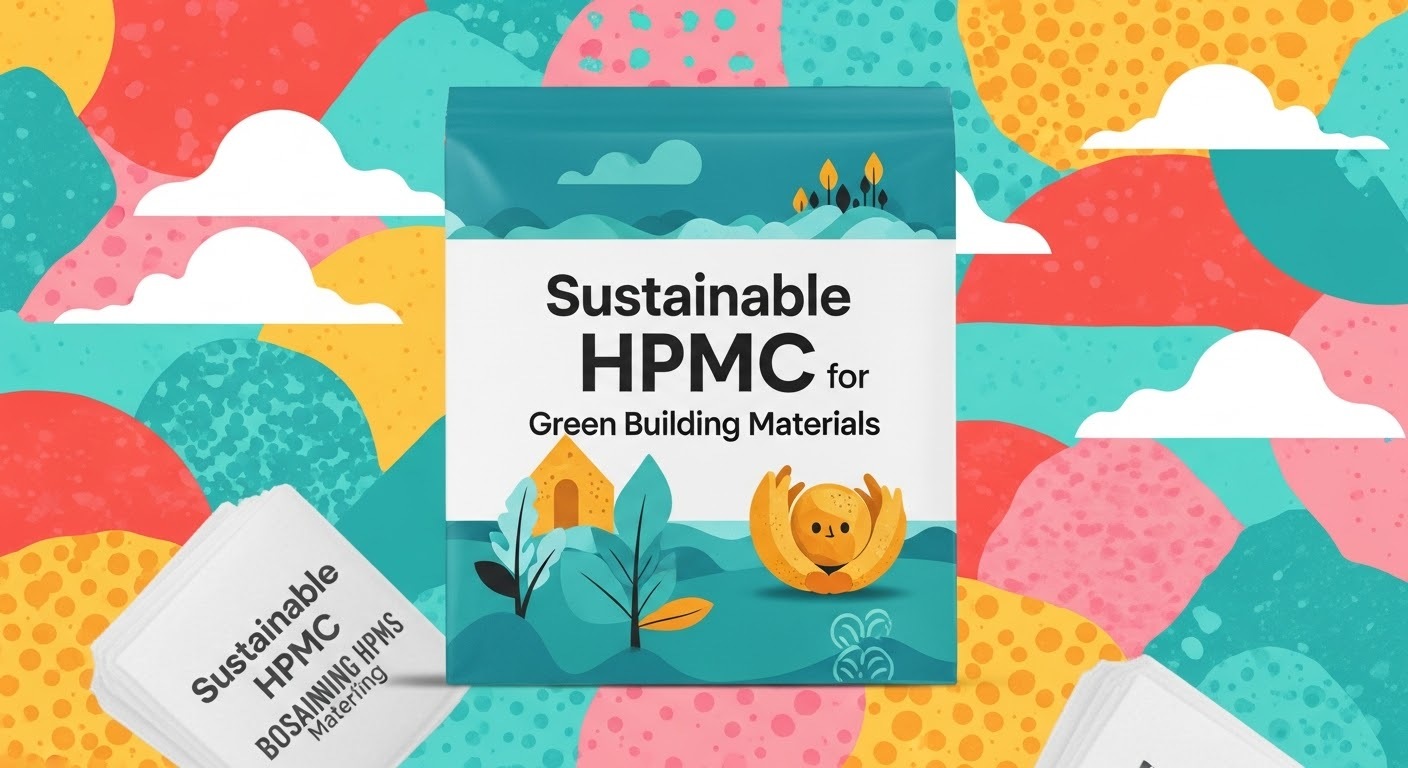HPMC in Green Building: Advancing Eco-Friendly Construction Solutions
Release time:
2025-09-18
Hydroxypropyl Methylcellulose (HPMC) is a non-toxic, plant-derived (typically from wood pulp or cotton linter) cellulose ether that has emerged as a critical additive in green building. Its unique physical and chemical properties—such as water retention, thickening, film-forming, and biodegradability—align with the core goals of green building: reducing environmental impact, improving resource efficiency, and enhancing indoor/outdoor sustainability. Below is a detailed breakdown of its role, eco-friendly advantages, key applications, and considerations for green construction.
1. Core Eco-Friendly Traits of HPMC: Why It Fits Green Building
Green building prioritizes materials that minimize carbon footprints, avoid toxic emissions, and support circularity. HPMC excels in these areas due to its inherent and process-related characteristics:
|
Trait |
Description |
Relevance to Green Building |
|
Renewable & Plant-Based Origin |
HPMC is derived from cellulose, a natural polymer found in plant cell walls (e.g., wood, cotton). Unlike petroleum-based additives (e.g., polyvinyl alcohol), it relies on renewable biomass. |
Reduces dependence on fossil fuels, lowers "cradle-to-gate" carbon emissions, and supports sustainable forestry (when sourced from FSC-certified wood pulp). |
|
Non-Toxic & Low VOC Emissions |
HPMC is chemically stable, non-irritating, and does not release Volatile Organic Compounds (VOCs) or harmful byproducts (e.g., formaldehyde, heavy metals) during production or use. |
Improves indoor air quality (IAQ)—a key metric for green certifications (LEED, BREEAM)—and eliminates health risks for construction workers and occupants. |
|
Biodegradable & Compostable |
In soil or aquatic environments, HPMC breaks down into harmless substances (glucose, water, CO₂) via microbial activity. It does not persist as microplastics or contaminate ecosystems. |
Supports "cradle-to-cradle" waste management: leftover HPMC-containing materials (e.g., mortar scraps) can decompose naturally, reducing construction landfill waste. |
|
Energy-Efficient Production |
Compared to synthetic additives, HPMC production requires lower temperatures and fewer hazardous chemicals. Modern manufacturers also optimize processes (e.g., solvent recycling) to cut energy use. |
Lowers the material’s embodied energy (total energy consumed during production), a critical factor in green building life-cycle assessments (LCAs). |
2. Key Applications in Green Building: Enhancing Sustainability of Core Materials
HPMC acts as a "performance enhancer" for construction materials, enabling them to meet green standards while maintaining (or improving) durability and functionality. Its most common uses include:
A. Eco-Friendly Mortars & Plasters
Mortars and plasters are foundational in building, but traditional formulations often suffer from poor workability, high water loss, or reliance on toxic additives. HPMC addresses these issues while boosting sustainability:
- Water Retention: HPMC slows the evaporation of water in mortar, ensuring cement fully hydrates. This reduces the need for rewetting (saving water) and prevents cracks—extending the material’s lifespan and reducing maintenance/repair waste.
- Workability & Adhesion: It thickens mortar, making it easier to apply (reducing labor time) and improving adhesion to substrates (e.g., brick, concrete). This minimizes material waste from poorly applied mortar that falls or fails.
- Low-Cement Mortars: By enhancing water retention, HPMC allows for formulations with less cement (a high-carbon material: 1 ton of cement emits ~0.8 tons of CO₂). For example, "eco-mortars" with HPMC can replace 10–20% of cement with fly ash (a industrial byproduct), cutting embodied carbon.
B. Green Wall & Vertical Garden Systems
Green walls are a hallmark of sustainable design (they reduce urban heat islands, improve air quality, and sequester CO₂). HPMC plays a critical role in the growing media and root barrier films of these systems:
- Growing Media Stabilization: HPMC is added to soil mixes to improve water retention and prevent erosion. This ensures plants thrive with less irrigation (saving water) and reduces the risk of soil runoff (protecting nearby waterways).
- Biodegradable Root Barriers: HPMC forms a thin, water-permeable film that prevents plant roots from damaging building facades. Unlike synthetic barriers (e.g., PVC), this film biodegrades over time, avoiding plastic waste.
C. Low-VOC Paints & Coatings
Green building requires paints with <50 g/L VOCs (per LEED standards). HPMC acts as a thickener and stabilizer in water-based, low-VOC paints:
- VOC Reduction: It eliminates the need for toxic solvent-based thickeners (e.g., xylene), keeping VOC levels low.
- Film-Forming: HPMC helps paint form a durable, even film that resists peeling. This extends the paint’s lifespan, reducing the frequency of repainting (and associated material waste).
D. Sustainable Tile Adhesives
Traditional tile adhesives often contain toxic resins or require excessive water. HPMC-modified adhesives offer eco-friendly alternatives:
- Water Retention: Prevents the adhesive from drying out too quickly, ensuring strong bonding to tiles and substrates. This reduces tile failure (and the need for replacement, which wastes materials).
- No Toxic Additives: Replaces synthetic resins with a natural thickener, making the adhesive safe for indoor use (e.g., kitchens, bathrooms) and compliant with IAQ standards.
3. Contribution to Green Building Certifications
HPMC-containing materials help projects qualify for leading green certifications by addressing key criteria:
|
Certification |
Key Criteria Addressed by HPMC |
|
LEED (Leadership in Energy and Environmental Design) |
- Reduced embodied carbon (via low-cement mortars).- Improved IAQ (low-VOC paints/adhesives).- Water efficiency (green wall irrigation, mortar water retention). |
|
BREEAM (Building Research Establishment Environmental Assessment Method) |
- Sustainable material sourcing (renewable HPMC).- Waste reduction (biodegradable residues, longer material lifespans). |
|
Living Building Challenge |
- Non-toxic materials (no VOCs or heavy metals).- Circularity (biodegradable HPMC, use of industrial byproducts like fly ash). |
4. Considerations for Maximizing HPMC’s Eco-Impact
To fully leverage HPMC’s sustainability benefits, green builders should prioritize:
- Sustainable Sourcing: Choose HPMC made from FSC-certified wood pulp or organic cotton linter to ensure responsible biomass harvesting.
- Optimized Dosage: Use the minimum effective amount of HPMC (typically 0.1–0.5% of material weight) to avoid overconsumption and reduce costs.
- End-of-Life Management: Dispose of leftover HPMC-containing materials (e.g., mortar scraps) via composting (where applicable) to capitalize on its biodegradability.
5. Future Trends: HPMC and Next-Gen Green Building
As green building evolves, HPMC is being integrated into innovative solutions:
- Carbon-Negative Mortars: Researchers are combining HPMC with algae-based additives to create mortars that sequester CO₂ during curing.
- Self-Healing Materials: HPMC’s film-forming properties are being tested to create "self-healing" concrete—when cracks form, HPMC releases a healing agent (e.g., lime) to seal them, extending the structure’s lifespan.
Conclusion
HPMC is more than just an additive—it is a "enabler" of green building. Its renewable origin, non-toxicity, and performance-enhancing properties allow construction teams to reduce environmental impact without compromising durability or functionality. From low-carbon mortars to eco-friendly green walls, HPMC is poised to play a central role in the transition to sustainable, resilient built environments.
Related News
2025-10-01
2025-09-18




